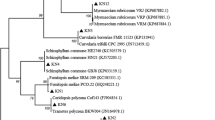Abstract
To obtain enzymatic preparations with higher laccase activity levels from Funalia floccosa LPSC 232, available for use in several applications, co-cultures with six filamentous microfungi were tested. A laccase non-producing soil fungus, identified as Penicillium commune GHAIE86, showed an outstanding ability to increase laccase activity (3-fold as compared to that for monoculture) when inoculated in 6-day-old F. floccosa cultures. Maximum laccase production with the F. floccosa and P. commune co-culture reached 60 U/mL, or twice that induced by chemical treatments alone. Our study demonstrated that co-culture with soil fungi might be a promising method for improving laccase production in F. floccosa. Although the enhancement of laccase activity was a function of P. commune inoculation time, two laccase isoenzymes produced by F. floccosa remained unchanged when strains were co-cultured. These data are compatible with the potential of F. floccosa in agricultural applications in soil, whose enzyme machinery could be activated by soil fungi such as P. commune.





Similar content being viewed by others
References
Alcántara T, Gómez J, Pazos M, Sanromán MA (2007) Enhanced production of laccase in Coriolopsis rigida grown on barley bran in flask or expanded-bed bioreactor. World J Microbiol Biotech 23:1189–1194
Almonacid L, Fuentes A, Ortiz J, Salas C, García-Romera I, Ocampo JA, Arriagada C (2015) Effect of mixing soil saprophytic fungi with organic residues on the response Solanum lycopersicum to arbuscular mycorrhizal fungi. Soil Use Manage 31:155–164
Arriagada C, Manquel D, Cornejo P, Soto J, Sampedro I, Ocampo JA (2012) Effect of the co-inoculation with saprobe and mycorrhizal fungi on Vaccinium corymbosum growth and some soil enzymatic activities. J Soil Sci Plant Nut 12:283–294
Arriagada C, Almonacid L, Cornejo P, García-Romera I, Ocampo JA (2014) Influence of an organic amendment comprising saprophytic and mycorrhizal fungi on soil quality and growth of Eucalyptus globulus in the presence of sewage sludge contaminated with aluminium. Arch Agron Soil Sci 60:1229–1248
Baldrian P (2004) Increase of laccase activity during interspecific interactions of white-rot fungi. FEMS Microbiol Ecol 50:245–253
Baldrian P (2006) Fungal laccases, occurrence and properties. FEMS Microbiol Rev 30:215–242
Baldrian P (2008) Wood-inhabiting ligninolytic basidiomycetes in soils: ecology and constraints for applicability in bioremediation. Fungal Ecol 1:4–12
Bertrand S, Schumpp O, Bohni N, Monod M, Gindro K, Wolfender JL (2013) De novo production of metabolites by fungal co-culture of Trichophyton rubrum and Bionectria ochroleuca. J Nat Prod 76:1157–1165
Boddy L (2000) Interspecific combative interactions between wood-decaying basidiomicetes. FEMS Microbiol Ecol 31:185–194
Bradford MM (1976) A rapid and sensitive method for the quantitation of microgram quantities of protein utilizing the principle of protein-dye binding. Anal Biochem 72:248–254
Chan-Cupul W, Heredia Abarca G, Martínez Carrera D, Rodríguez Vázquez R (2014) Enhancement of ligninolytic enzyme activities in a Trametes maxima–Paecilomyces carneus co-culture: key factors revealed after screening using a Plackett–Burman experimental design. Electron J Biotechnol 17:114–121
Colombo JC, Cabello M, Arambarri AM (1996) Biodegradation of aliphatic and aromatic hydrocarbons by natural soil microflora and pure culture of imperfect and ligninolitic fungi. Environ Pollut 94:355–362
Crowe JD, Olsson S (2001) Induction of laccase activity in Rhizoctonia solani by antagonistic Pseudomonas fluorescens strains and a range of chemical treatments. Appl Environ Microb 67:2088–2094
Dantán-González E, Vite-Vallejo O, Martínez-Anaya C, Méndez-Sánchez M, González MC, Palomares LA, Folch-Mallol J (2008) Production of two novel laccase isoforms by a thermotolerant strain of Pycnoporus sanguineus isolated from an oil-polluted tropical habitat. Int Microbiol 11:163–169
Díaz R, Saparrat M, Jurado M, García-Romera I, Ocampo JA, Martínez MJ (2010) Biochemical and molecular characterization of Coriolopsis rigida laccases involved in transformation of the water soluble fraction of “alpeorujo”. Appl Microbiol Biotechnol 88:133–142
Dwivedi P, Vivekanand V, Pared N, Sharma A, Singh RP (2011) Co-cultivation of mutant Penicilliym oxalicum SAUE-3.510 and Pleurotus ostreatus for simultaneous biosynthesis or xylanase and laccase under solid-state fermentation. New Biotechnol 28:617–626
Evans JB, Niven CF (1951) Nutrition of the heterofermentative Lactobacilli that cause greening of cured meat products. J Bacteriol 62:599–603
Flores C, Vidal C, Trejo-Hernández MR, Galindo E, Serrano-Carreón L (2009) Selection of Trichoderma strains capable of increasing laccase production by Pleurotus ostreatus and Agaricus bisporus in dual cultures. J Appl Microbiol 106:249–257
Flores C, Casasanero R, Trejo-Hernández MR, Galindo E, Serrano CL (2010) Production of laccase by Pleurotus ostreatus in submerged fermentation in co-culture with Trichoderma viride. J Appl Microbiol 108:810–817
Gao SS, Li XM, Zhang Y, Li CS, Cui CM, Wang BG (2011) Comazaphilones A-F, Azaphilone derivatives from the marine sediment derived fungus Penicillium commune QSD-17. J Nat Prod 74:256–251
Gao N, Liu C-X, Xu Q-M, Cheng J-S, Yuan Y-J (2018) Simultaneous removal of ciprofloxacin, norfloxacin, sulfamethoxazole by co-producing oxidative enzymes system of Phanerochaete chrysosporium and Pycnoporus sanguineus. Chemosphere 195:146–155
Gómez J, Rodríguez D, Pazos M, Sanromán MA (2006) Applicability of Coriolopsis rigida for biodegradation of polycyclic aromatic hydrocarbons. Biotechnol Lett 28:1013–1017
Griffith GS, Rayner ADMR, Wildman HG (1994) Interspecific interactions and mycelial morphogenesis of Hypholoma fasciculare (Agaricaceae). Nova Hedwigia 59:47–75
Guillén F, Martínez AT, Martínez MJ (1992) Substrate specificity and properties of the aryl-alcohol oxidase from the ligninolytic fungus Pleurotus eryngii. Eur J Biochem 209:603–611
Guo M, Lu F, Liu M, Li T, Pu J, Wang N, Liang P, Zhang C (2008) Purification of recombinant laccase from Trametes versicolor in Pichia methanolica and its use for the decolorization of anthraquinone dye. Biotechnol Lett 30:2091–2096
Hall TA (1999) BioEdit: a user friendly biological sequence alignment editor and analysis program for Windows 95/98/NT. Nucleic Acids Symp Ser 41:95–98
Hernández C, Milagres AMF, Vázquez-Marrufo G, Muñoz-Páez KM, García-Pérez JA, Alarcón E (2018) An ascomycota coculture in batch bioreactor is better than polycultures for cellulase production. Folia Microbiol doi 63:467–478. https://doi.org/10.1007/s12223-018-0588-1
Iakovlev A, Stenlid J (2000) Spatiotemporal patterns of laccase activity in interacting mycelia of wood-decaying basidiomycete fungi. Microbial Ecol 39:236–245
Ibañez CG (1998) Contribución al estudio de hongos xilófagos en la Provincia de Misiones, Argentina (Basidiomycetes, Aphyllophorales). II. Polyporaceae. Bol Soc Argent Bot 33:157–169
Jain N, Bhargava A, Tarafdar CJ, Singh KS, Panwar J (2013) A biomimetic approach towards synthesis of zinc oxide nanoparticles. Appl Microbiol Biotechnol 97:859–869
Kumari S, Narian R (2016) Decolorization of synthetic brilliant green carpet industry dye through fungal co-culture technology. J Environ Manage 180:172–179
Liu FZ, Ren JW, Tang JS, Liu XZ, Che YS, Yao XS (2013) Cyclohexanone derivatives with cytotoxicity from the fungus Penicillium commune. Fitot 87:78–83
Ma K, Ruan Z (2015) Production of a lignocellulolytic enzyme system for simultaneous bio-delignification and saccharification of corn stover employing co-culture of fungi. Bioresour Technol 175:586–593
Mali T, Kuuskeri J, Shah F, Lundell TK (2017) Interactions affects hyphal growth and enzyme profiles in combinations of coniferous wood-decaying fungi of Agaricomycetes. PLoS One 12:e0185171
Mata G, Murrieta Hernández DM, Iglesias Andreu LD (2005) Changes in lignocellulolytic enzyme activities in six Pleurotus spp. strains cultivated on coffee pulp in confrontation with Trichoderma spp. World J Microbiol Biotechnol 21:143–150
Mohamed S, Al-Yami M, Sadik A (2016) Detection of mycophages associated with fungal strains isolated from soil of KSA and identified via 18S rRNA gene. J Pharm Biol Chem Sci 7:1375–1380
Muñoz C, Guillén F, Martínez AT, Martínez MJ (1997) Induction and characterization of laccase in the ligninolytic fungus Pleurotus eryngii. Curr Microbiol 34:1–5
Oliveira M, Arenas M, Lage O, Cunha M, Amorim MI (2017) Epiphytic fungal community in Vitis vinifera of the Portuguese wine regions. Lett App Microbiol 66:93–102
Out B, Boyle S, Cheeptham N (2016) Identification of fungi from soil in the Nakimu caves of Glacier National Park. J Exp Microbiol Immunol 2:26–32
Pitt JI (2000) A laboratory guide to common Penicillium species. 3rd Ed. Food Science. Australia Publishers. CSIRO, Australia, pp 197
Quaratino D, Ciaffi M, Federici E, D’Annibale A (2008) Response surface methodology study of laccase production in Panus tigrinus liquid cultures. Biochem Eng J 39:236–245
Sampedro I, Aranda E, Martín J, García-Garrido JM, García-Romera I, Ocampo JA (2004) Saprobic fungi decrease plant toxicity caused by olive mill residues. Appl Soil Ecol 26:149–156
Samson AR, Hoekstra ES, Frisvad JC, Filtenborg O (1996) Introduction to food-borne fungi. Centraalbureau voor Schimmelcultures (CBS), Baarn, The Netherlands. No. Ed. 5 pp 322
Sánchez-López MI, Vanhulle SF, Mertens V, Guerra G, Figueroa SH, Decock C, Corbisier AM, Penninckx MJ (2008) Autochthonous white rot fungi from the tropical forest: potential of Cuban strains for dyes and textile industrial effluents decolourisation. Afr J Biotech 7:1983–1990
Saparrat MCN (2004) Optimizing production of extracellular laccase from Grammothele subargentea CLPS no. 436 strain. World J Microb Biot 20:583–586
Saparrat MCN, Guillén F, Arambarri AM, Martínez AT, Martínez MJ (2002) Induction, isolation and characterization of two laccases from the white rot basidiomycete Coriolopsis rigida. App Environ Microbiol 68:1534–1540
Saparrat MCN, Mocchiutti P, Liggieri CS, Aulicino MB, Caffini NO, Balatti PA, Martínez MJ (2008) Ligninolytic enzyme ability and potential biotechnology applications of the white-rot fungus Grammothele subargentea LPSC no. 436 strain. Process Biochem 43:368–375
Saparrat MCN, Jurado M, Díaz R, García-Romera I, Martínez MJ (2010) Transformation of the water soluble fraction from “alpeorujo” by Coriolopsis rigida: the role of laccase in the process and its impact on Azospirillum brasiliense survival. Chemosphere 78:72–76
Saparrat MCN, Balatti P, Arambarri AM, Martínez MJ (2014) Coriolopsis rigida, a potential model of white-rot fungi that produce extracellular laccases: a review. J Ind Microbiol Biotechnol 41:607–617
Savoie JM, Mata G, Mamoun M (2001) Variability in brown line formation and extracellular laccase production during interaction between white-rot basidiomycetes and Trichoderma harzianum biotype Th2. Mycologia 93:243–248
Shang Z, Li X, Meng L, Li C, Gao S, Huang C, Wang B (2012) Chemical profile of the secondary metabolites produced by a deep-sea sediment-derived fungus Penicillium commune SD-118. Chin J Oceanol Limnol 30:305–314
Svahn KS, Chryssanthou E, Olsen BR, Bohlin L, Göransson U (2015) Penicillium nalgiovense Laxa isolated from Antarctica is a new source of the antifungal metabolite amphotericin B. Fungal Biol Biotech 2:1
Velázquez-Cedeño MA, Farnet AM, Ferré E, Savoie JM (2004) Variations of lignocellulosic activities in dual cultures of Pleurotus ostreatus and Trichoderma longibrachiatum on unsterilized wheat straw. Mycologia 96:712–719
Wagener ER, Davis DN, Diener LU (1980) Penitrem A and roquefortine production by Penicillium commune. Appl Environ Microbiol 39:882–887
White TJ, Burns T, Lee S, Taylor JW (1990) Amplification and direct sequencing of fungal ribosomal RNA genes for phylogenetics. In: Innis MA, Gelfand DH, Sninsky JJ, White TJ (eds) PCR protocols: a guide to methods and applications. Academic Press, New York, pp 315–320
Zhang H, Hong YZ, Xiao YZ, Yuan J, Tu XM, Zhang XQ (2006) Efficient production of laccases by Trametes sp. AH28-2 in cocultivation with a Trichoderma strain. Appl Microbiol Biotechnol 73:89–94
Acknowledgements
G. Heredia wishes to thank the Agencia Española de Cooperación Internacional (AECI-MAEC Program) for providing financial support for a sabbatical stay at the Department of Microbiology, Estación Experimental del Zaidín. M.C.N. Saparrat is a researcher from CONICET in Argentina. Inmaculada Sampedro wishes to thank MINECO for her “Ramón y Cajal” contract. The English text was corrected by Michael O’Shea.
Funding
This study was supported by Spanish projects AGL2008-00572/AGR and Prolipapel II S-2009AMB-1480 as well as the Agencia Nacional de Promoción Científíca y Tecnológica (PICT 2015-1620 to Saparrat, M.).
Author information
Authors and Affiliations
Contributions
R.D. and G.H. contributed equally to this study.
Corresponding author
Electronic supplementary material
Supplementary Fig. S1
(DOCX 69 kb)
Rights and permissions
About this article
Cite this article
Rodríguez, R.D., Heredia, G., Siles, J.A. et al. Enhancing laccase production by white-rot fungus Funalia floccosa LPSC 232 in co-culture with Penicillium commune GHAIE86. Folia Microbiol 64, 91–99 (2019). https://doi.org/10.1007/s12223-018-0635-y
Received:
Accepted:
Published:
Issue Date:
DOI: https://doi.org/10.1007/s12223-018-0635-y




